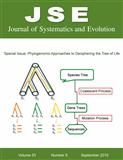Table of Contents
-

Volume 53 Issue 5
Special issue: Phylogenomic Approaches to Deciphering the Tree of Life
Cover illustration: The hierarchical model for multigene sequence data. The model consists of three components—alignments, gene trees and the species tree. This hierarchical model involves two layers; the sequences-and-genetree layer and the genetree-and-speciestree layer. The model assumes that the gene trees are generated from a coalescent process occurring along the lineages of the species tree, while the sequences are generated from a mutation process occurring on the branches of the gene trees. See Liu et al., pp. 380–390 in this issue. The cover is designed by Alice Tangerini and Lauren Bassing based on Fig. 1 from Liu et al. [Detail] ...
Editors-in-Chief
Song Ge
Jun Wen
Song Ge
Jun Wen
Impact Factor
3.7
JCR 2022 IF ranking: 60/238 (Plant Sciences, top 25%, Q2 quartile)
Journal Abbreviation: J Syst Evol
CN: 11-5779/Q
Frequency: Bi-monthly
Journal Abbreviation: J Syst Evol
| ISSN: | 1674-4918 (Print) 1759-6831 (Online) |
Frequency: Bi-monthly

Scan to view the journal on your mobile
device
device

Scan to follow us on WeChat







